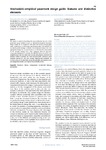Mostrar o rexistro simple do ítem
Mechanistic-empirical pavement design guide : features and distinctive elements
| dc.contributor.author | Martínez-Díaz, Margarita | |
| dc.contributor.author | Pérez Pérez, Ignacio | |
| dc.date.accessioned | 2016-12-09T19:37:09Z | |
| dc.date.available | 2016-12-09T19:37:09Z | |
| dc.date.issued | 2015 | |
| dc.identifier.citation | MARTINEZ DIAZ, Margarita y PEREZ, Ignacio. Mechanistic-empirical pavement design guide: características y elementos distintivos. Revista de la Construcción [online]. 2015, vol.14, n.1, pp.32-40. ISSN 0718-915X. http://dx.doi.org/10.4067/S0718-915X2015000100004. | es_ES |
| dc.identifier.issn | 0718-915X | |
| dc.identifier.uri | http://hdl.handle.net/2183/17742 | |
| dc.description.abstract | [Abstract] This paper is aimed at describing the most distinctive features of the pavement design method known as Mechanistic-Empirical Pavement Design Guide and to compare it with other renowned methodologies, while emphasizing its advantages and disadvantages. The MEPDG can accurately predict damage evolution, thus helping to choose the most appropriate design for new pavements or to schedule the conservation of the already existing ones. After analyzing different pavement design and management methods, the MEPDG stands out as the most comprehensive one as it takes into account and properly combines the greatest number of factors that affect the pavement. Therefore, some countries outside the USA have already imported and calibrated this method, what, at the same time, allows the scientific community to carry out comparative studies and improve its small deficiencies. | es_ES |
| dc.description.abstract | [Resumen] El objetivo de este artículo es describir los rasgos más característicos del método de diseño de firmes conocido como Mechanistic-Empirical Pavement Design Guide, así como compararlo con otras metodologías de renombre, destacando sus ventajas y desventajas. El MEPDG puede predecir con precisión la evolución de los deterioros, ayudando por tanto a elegir el diseño más adecuado para el caso de firmes de nueva construcción, o a programar la conservación de los ya existentes. Tras analizar diferentes métodos de diseño y gestión de firmes, el MEPDG destaca como el más completo al ser el que tiene en cuenta un mayor número de factores que afectan al firme. Por ello algunos países fuera de EEUU ya han importado y calibrado este método, lo que al mismo tiempo permite a la comunidad científica llevar a cabo estudios comparativos y mejorar sus pequeñas deficiencias. | es_ES |
| dc.language.iso | eng | es_ES |
| dc.publisher | Escuela de Construcción Civil, Pontificia Universidad Católica de Chile | es_ES |
| dc.relation.uri | http://dx.doi.org/10.4067/S0718-915X2015000100004 | es_ES |
| dc.rights | Reconocimiento-NoComercial 4.0 Internacional | es_ES |
| dc.rights.uri | http://creativecommons.org/licenses/by-nc/4.0/ | * |
| dc.subject | Pavement | es_ES |
| dc.subject | Design | es_ES |
| dc.subject | Management | es_ES |
| dc.subject | Incremental damage | es_ES |
| dc.subject | Optimization | es_ES |
| dc.subject | Pavimentos | es_ES |
| dc.subject | Diseño | es_ES |
| dc.subject | Administración | es_ES |
| dc.subject | Daño incremental | es_ES |
| dc.subject | Optimización | es_ES |
| dc.title | Mechanistic-empirical pavement design guide : features and distinctive elements | es_ES |
| dc.title.alternative | Mechanistic-empirical pavement design guide : características y elementos distintivos | es_ES |
| dc.type | info:eu-repo/semantics/article | es_ES |
| dc.rights.access | info:eu-repo/semantics/openAccess | es_ES |
| UDC.journalTitle | Revista de la Construcción | es_ES |
| UDC.volume | 14 | es_ES |
| UDC.issue | 1 | es_ES |
| UDC.startPage | 32 | es_ES |
| UDC.endPage | 40 | es_ES |
| dc.identifier.doi | http://dx.doi.org/10.4067/S0718-915X2015000100004 |
Ficheiros no ítem
Este ítem aparece na(s) seguinte(s) colección(s)
-
CITEEC-CGM - Artigos [93]






